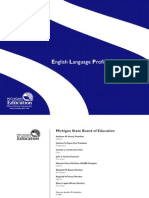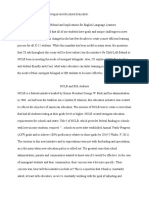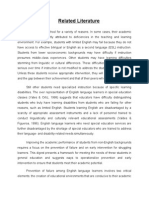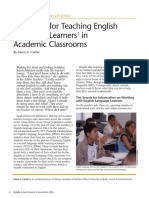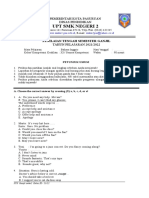The Case For Structured English Immersion
The Case For Structured English Immersion
Uploaded by
Tom WayCopyright:
Available Formats
The Case For Structured English Immersion
The Case For Structured English Immersion
Uploaded by
Tom WayOriginal Title
Copyright
Available Formats
Share this document
Did you find this document useful?
Is this content inappropriate?
Copyright:
Available Formats
The Case For Structured English Immersion
The Case For Structured English Immersion
Uploaded by
Tom WayCopyright:
Available Formats
April 2009 | Volume 66 | Number 7 Supporting English Language Learners Pages 42-46
The Case for Structured English Immersion
Three states and many school districts are finding that emphasizing English language instruction offers ELLs an accelerated path to success.
Kevin Clark
When Arizona voters passed a ballot initiative in 2000 that required all
April 2009
English language learners to be educated through structured English immersion (SEI), the idea seemed simple enough: Teach students the English language quickly so they can do better in school. But as other states, districts, and schools that have contemplated an SEI program have learned, the devil is in the details. As it turns out, the simple goal to "teach English quickly" frequently evokes legal wrangling, emotion, and plain old demagoguery. Few people would disagree that English language proficiency is necessary for academic success in U.S. schools. Less clear, however, is the optimal pathway for helping language-minority students master English. Conflicting ideologies, competing academic theories, and multiple metrics for comparing different approaches have rendered many schools, districts, and educators paralyzed by confusion. Bill Holden, principal of a California elementary school in which ELLs are three-fourths of the student population, told me, "At a certain point there were just so many mixed messages and contradictory directives and policies that we didn't really know what to do." Despite the controversy, however, many schools in Arizona and other states have implemented structured English immersion or are in the process of doing so. As I have worked with educators, school boards, and the Arizona English Language Learners Task Force to explore, design, and implement structured programs, a common theme emerges: These programs have the potential to accelerate ELLs' English language development and linguistic preparation for grade-level academic content.
Why Do Schools Implement Structured English Immersion?
Several factors usually account for school and district leaders' decisions to opt for structured English immersion. In three states (California, Arizona, and Massachusetts), the reason is straightforward: Laws passed through voter initiatives now require structured English immersion and restrict bilingual education.
Another factor is that most state student performance assessments are conducted in English, and schools or districts that miss targets face increased scrutiny and possible sanctions. This provides added incentive for schools to get students' English proficiency up to speed as soon as possible. A third factor is the burgeoning subpopulation of ELL students who reach an intermediate level of English competence after a few yearsand then stop making progress. These students (more than 60 percent of all ELLs in some districts, according to analyses I conducted for 15 districts) possess conversational English competence. But they lag in their ability to apply the rules, structures, and specialized vocabularies of English necessary for grade-level academic coursework; and their writing typically features an array of structural errors. My analyses showed that the typical intermediate-level ELL scores well below proficient on state-level tests in English language arts. Some educators have acknowledged, in fact, that intermediate English competence is the logical outcome of their current practices and program designs. "Once we really analyzed our program for ELL students," one district superintendent told me, "we saw that we really didn't teach English to our students. We were teaching in English, but not really teaching English."
Confusion About Structured English Immersion
Keith Baker and Adriana de Kanter (1983) first coined the term structured English immersion (SEI) in a recommendation to schools to teach English to non-native speakers by using program characteristics from the successful French immersion programs in Canada. In 1991, J. David Ramirez and his colleagues conducted a voluminous study of ELL instructional programs and found that SEI programs shared two basic components: (1) teachers maximize instruction in English and (2) teachers use and teach English at a level appropriate to the abilities of the ELLs in the class (Ramirez, Yuen, & Ramey, 1991). Since then, many people have taken a crack at defining structured English immersion. The definition presented to voters in Massachusetts was similar to those used in election materials in California and Arizona: "Nearly all classroom instruction is in English but with the curriculum and presentation designed for children who are learning the language" (Massachusetts Department of Education, 2003, p. 7). But when Arizona's English Language Learner Task Force began meeting in late 2006, it found that few people seemed to know what SEI should look like. Many teachers, academics, and school administrators who testified before the task force had a negative view of the statemandated approach. Presenters frequently confused SEI with submersion, the process of placing ELLs in regular classrooms that feature little or no instructional modifications and minimal instruction in the actual mechanics of English. Others viewed SEI as synonymous with specially designed academic instruction in English (SDAIE), also known as sheltered instruction, which features an array of strategies designed to help students of intermediate or higher proficiency access grade-level subject matter (Aha!, 2007).
Experience Fills in the Details
Notwithstanding the hodgepodge of definitions, mixed messages, and underlying emotions, educators have implemented structured English immersion programs at both the elementary and secondary levels. A framework for effective SEI is emerging that includes the following elements. Significant amounts of the school day are dedicated to the explicit teaching of the English language, and students are grouped for this instruction according to their level of English proficiency. In Arizona, all ELLs must receive four hours of daily English language development. Other states and districts also provide large amounts of explicit instruction in English. For example, in Massachusetts, students at the lowest levels of English competence receive a minimum of two and one-half hours of daily English language development. Grouping students for English-language instruction according to their English language ability is an important component of SEI because it enables teachers to effectively design language lessons. True beginners, for example, can benefit greatly from a direct lesson on common nouns, whereas intermediate students need to understand how subordinating conjunctions are used in academic writing. The English language is the main content of SEI instruction. Academic content plays a supporting, but subordinate, role. The dominant focus is language itself: its rules, uses, forms, and application to daily school and nonschool situations and topics. The operant principle is that students must have a strong understanding of the English language before they can be expected to learn grade-level content. Massachusetts, for example, tightly defines English language development instruction as "explicit, direct instruction about the English language intended to promote English language acquisition by LEP students and to help them 'catch up' to their student peers who are proficient in English" (Massachusetts Department of Education, 2006, p. 2). Martin Ramirez, principal of a Yuba City, California, high school that has gained national attention for its SEI program, puts the language-content issue this way: We are charged with giving our ELLs a rigorous core content curriculum that is comparable to their English-speaking peers. But just putting them in a science course does not make it a rigorous curriculum. They will get access when they possess the language skills to be able to understand the content, and that is the role of our SEI program. English is the language of instruction; students and teachers are expected to speak, read, and write in English. Accelerated language programs like SEI are based, in part, on the comprehensible output theory (Swain, 1985). This means that we cannot expect students to advance their language competence mainly through oral comprehension; instead, students get more proficient in English when they actually try to produce increasingly complex English language sentences. All materials and instruction in SEI programs are in English. For this reason, teachers and instructional support staff are not required to be able to speak a language other than English.
Although controversial, the limit on use of students' home languages keeps the goal of SEI programs clear. One administrator in an Idaho district summarized the rationale: "Unfortunately, our ELD classrooms in the past sometimes featured as much Spanish as English. It was just sending a very confusing message to students and staff." Teachers use instructional methods that treat English as a foreign language. Structured English immersion programs reject the notion that teaching in English is the same as teaching English and that complex language skills can be learned through osmosis. SEI's foreign-language orientation calls for active, direct, and explicit instructional methods. Students have abundant opportunities to learn and produce new and more complex English language structures. Students learn discrete English grammar skills. In SEI classrooms, teachers try to accelerate students' natural tendency to acquire language by providing grammatically focused lessons that raise students' conscious awareness of how English works while engaging them in relevant, age-appropriate learning tasks. Students are overtly taught English pronunciation and listening skills; word building; word-order rules; a wide range of vocabulary (synonyms, antonyms, survival vocabulary, academic word groups); and formulaic expressions not easily explained by grammar analysis ("There you go again"; "What's up with that?"). The overt teaching of verb tensesalmost nonexistent in most traditional public school English language development programsis typically the anchor of many of these programs, accounting for up to one-fourth of the total instructional time. Rigorous time lines are established for students to exit from the program. English language learners have little time to waste. While they are learning English, their English-proficient classmates continue to move ahead. For that reason, most SEI programs are designed to last one academic year. An SEI graduate should possess a foundational understanding of the mechanics, structure, and vocabulary of English that enables him or her to meaningfully access core content. These SEI program graduates, however, are not finished learning English. Indeed, until students are reclassified as fluent English proficient, they are entitled to support services. In Yuba City, for example, when students exit the SEI program, they are enrolled in a mixture of sheltered and mainstream courses, including one period of advanced English language development. Federal law requires that students who have been reclassified be monitored for a two-year period.
Charting New Territory
Each of these program elements in some way runs counter to the assumptions and beliefs that have guided ELL program development throughout the last 30 years. In Arizona and elsewhere, advocates of structured English immersion face strong criticism from detractors who argue, among other things, that these programs are segregatory, experimental, not based on research, nonculturally affirming, damaging to students' self-esteem, and perhaps even illegal (Adams, 2005; Combs, Evans, Fletcher, Parra, & Jimnez, 2005; Krashen, Rolstad, & MacSwan, 2007). Proponents of SEI maintain that students can learn English faster than many theories suggest,
that grouping students by language ability level is necessary for successful lesson design, and that the research support for immersion language-teaching methods and program design principles is solid (Arizona English Language Learners Task Force, 2007; Baker, 1998; Judson & Garcia-Dugan, 2004). As for the question of self-esteem, SEI advocates point out that ELLs are motivated by measurable success in learning the fundamentals of English, as well as by the improved reading comprehension, enhanced writing skills, and higher levels of achievement in core subjects that come from these enhanced language skills. On the legal front, ballot initiatives requiring SEI programs have been found to comport with federal law. Under the federal framework, as articulated in Castaeda v. Pickard (1981), immersion programs are viewed as "sequential," in that their goal is to provide foundational English skills before students participate in a full range of academic content courses.
SEI Programs in Action
George Washington Elementary School in Madera, California, enrolls more than 500 English language learners in grades K6. Located in the middle of a Spanish-dominant portion of a town in central California, the school was a magnet bilingual education site for decadesand unfortunately one of the lowest-achieving schools in the district. The school missed state and federal academic performance targets for years, and fewer than 3 percent of ELLs annually were reclassified as fully English proficient. District data analyses showed that after the first full year of SEI program implementation, the school gained almost 30 points on state test metrics, and English language growth rates tripled in all grades, easily exceeding district and federal targets. The reclassification rate last year quadrupled to 12 percent. Perhaps most significant, almost 50 percent of the school's intermediate students advanced to the next level of proficiency or met the criteria for being fully English proficient. Before the SEI program, 70 percent of the school's ELL population regularly showed no English language growthor even regressedon the state's yearly English assessment. Here's what an average day looks like for an ELL student at George Washington Elementary School:
Pronunciation and listening skills, 20 minutes. Vocabulary, 30 minutes. Verb tense instruction, 20 minutes. Sentence structure, 20 minutes. Integrated grammar skills application, 20 minutes. English reading and writing, 60 minutes. Math (specially designed academic instruction in English), 40 minutes. Science, social science, P.E., 40 minutes.
At Yuba City High School in Northern California, almost half of the school's 450 ELLs test at
intermediate or below on the state's language assessment. These students are enrolled in four periods of daily English language development courses: Conversational English and Content Area Vocabulary, English Grammar, English Reading, and English Writing. The school offers three levels for each course; students take an assessment every six weeks that could qualify them to move to the next level. Some students move so quickly that they exit the SEI program in less than a year. After the first year of Yuba City's SEI program, the proportion of students reclassified as fully English proficient tripled to 15 percent, nearly twice the state average.
Rethinking Assumptions and Beliefs
Not surprisingly, the decision to implement a structured English immersion programwhether by law or by choicefrequently brings about conflicts over ideology, pedagogy, and the very role of schooling for English language learners in a culturally and linguistically diverse society. Notwithstanding these challenges, an increasing number of schools, districts, and states across the country have seen that structured English immersion can help students gain the English language skills that are crucial for academic success and opportunities beyond school. As Adela Santa Cruz, director of the Office of English Language Acquisition Services for the Arizona Department of Education, said, We understand that implementing an SEI program requires some new ways of thinking and teaching, but once teachers and administrators come to understand SEI, they see it as a positive and effective vehicle for helping ELLs learn English much faster than we thought.
References
Adams, M. (2005). Unmasking the myths of structured English immersion. Cambridge, MA: Center for Critical Education. Available: www.worldlanguage.com/ Articles/59.htm Aha! (2007). Report of state-wide district survey to the Arizona English Language Learners Task Force. Tempe, AZ: Author. Arizona English Language Learners Task Force. (2007). Research summary and bibliography for structured English immersion programs [Online]. Phoenix, AZ: Author Available: www.asu.edu/educ/sceed/azell/model_component_research.pdf Baker, K. (1998). Structured English immersion breakthrough in teaching limitedEnglish-proficient students. Phi Delta Kappan, 80(3), 199204. Available: http:// pdkintl.org/kappan/kbak9811.htm Baker, K., & de Kanter, A. (Eds.). (1983). Bilingual education: A reappraisal of federal policy. Lexington, MA: Lexington Books. Castaeda v. Pickard. 648 F. 2d 989 (5th Cir. 1981). Combs, C., Evans, C., Fletcher, T., Parra, E., & Jimnez, A. (2005). Bilingualism for the children: Implementing a dual-language program in an English-only state.
Educational Policy, 19(5), 701728. Judson, E., & Garcia-Dugan, M. (2004). The effects of bilingual education programs and structured English immersion programs on student achievement. Phoenix: Arizona Department of Education. Krashen, S., Rolstad, K., & MacSwan, J. (2007). Review of "Research Summary and Bibliography for Structured English Immersion Programs" of the Arizona English Language Learners Task Force. Takoma Park, MD: Institute for Language and Education Policy. Available: www.elladvocates.org/documents/AZ/ Krashen_Rolstad_MacSwan_review.pdf Massachusetts Department of Education. (2003). Questions and answers regarding Chapter 71A: English language education in public schools [Online]. Malden, MA: Author. Available: www.doe.mass.edu/ell/chapter71A_faq.pdf Massachusetts Department of Education. (2006). Designing and implementing sheltered English immersion (SEI) programs in low incidence districts. Malden, MA: Author. Ramirez, J. D., Yuen, S. D., & Ramey, D. R. (1991). Final report: Longitudinal study of structured immersion strategy, early-exit, and late-exit transitional bilingual education programs for language-minority children. San Mateo, CA: Aguirre International. Swain, M. (1985) Communicative competence: Some roles of comprehensible input and comprehensible output in its development. In S. Gass & C. Madden (Eds.), Input in second language acquisition (pp. 235256). New York: Newbury House.
Kevin Clark is President of Clark Consulting and Training in Clovis, California; 559-299-5855; clarkcon@comcast. net For the past 20 years, he has assisted schools, districts, and states with the design, implementation, and evaluation of education programs for English language learners. Copyright 2009 by ASCD
Contact Us | Copyright Information | Privacy Policy | Terms of Use 2009 ASCD
You might also like
- The 6 Principles for Exemplary Teaching of English Learners: Grades K-12, First EditionFrom EverandThe 6 Principles for Exemplary Teaching of English Learners: Grades K-12, First EditionNo ratings yet
- Focus On Elementary What Is Good Teaching For Elementary English Language LearnersDocument7 pagesFocus On Elementary What Is Good Teaching For Elementary English Language LearnersMatt ChenNo ratings yet
- Language and Society-Research ProposalDocument8 pagesLanguage and Society-Research Proposalp3tru_mzq100% (2)
- LeadershipDocument7 pagesLeadershipapi-267989879No ratings yet
- Chapter 2 RevisedDocument11 pagesChapter 2 RevisedAubrey FenolNo ratings yet
- English Lang 153694 7. Proficiency StandardsDocument69 pagesEnglish Lang 153694 7. Proficiency StandardsSarah EnjadNo ratings yet
- Zainab Muhammad ESC 759-Foundations of Bilingual and Bicultural Education Professor SmithDocument8 pagesZainab Muhammad ESC 759-Foundations of Bilingual and Bicultural Education Professor Smithapi-341111705No ratings yet
- Improving Literacy For English LearnersDocument4 pagesImproving Literacy For English LearnersTarcisio Cajuhi PimentelNo ratings yet
- Academic Language and Ells by - U S Department of EducationDocument2 pagesAcademic Language and Ells by - U S Department of Educationapi-318193039No ratings yet
- Final Reaserch Based ProjectDocument7 pagesFinal Reaserch Based ProjectjamesholanNo ratings yet
- English Proficiency LocalDocument3 pagesEnglish Proficiency LocalYvanne Kris IVNo ratings yet
- 3 Statement of The ProblemDocument17 pages3 Statement of The ProblemCharlton BrutonNo ratings yet
- Ed 535608Document29 pagesEd 535608Aphro ChuNo ratings yet
- Preparing All Teachers To Meet The Needs of English Language LearnersDocument29 pagesPreparing All Teachers To Meet The Needs of English Language LearnersCenter for American ProgressNo ratings yet
- Winkelmanlitreview 2015 FinalDocument21 pagesWinkelmanlitreview 2015 Finalapi-257754554No ratings yet
- Improving Vocabulary and Comprehension Skills in Esl Students Through Language ProficiencyDocument15 pagesImproving Vocabulary and Comprehension Skills in Esl Students Through Language ProficiencysuhanalipNo ratings yet
- ESL 2010 Program Review - BCCDocument19 pagesESL 2010 Program Review - BCCMykelBedisNo ratings yet
- Aiming For Equity: Preparing Mainstream Teachers For Inclusion or Inclusive Classrooms?Document29 pagesAiming For Equity: Preparing Mainstream Teachers For Inclusion or Inclusive Classrooms?Azra ThaqiNo ratings yet
- Shin, S. J. (2008) - Preparing Non-Native English-Speaking ESL Teachers.Document21 pagesShin, S. J. (2008) - Preparing Non-Native English-Speaking ESL Teachers.gabar.coalNo ratings yet
- Background of The StudyDocument30 pagesBackground of The StudyMarvin Yebes ArceNo ratings yet
- Translanguaging and Bilingual Learners - A Study of How Translangu - 112412Document91 pagesTranslanguaging and Bilingual Learners - A Study of How Translangu - 112412Abonalla,Rycha Gaile Marie GarciaNo ratings yet
- Related LiteratureDocument4 pagesRelated LiteratureJorick ArellanoNo ratings yet
- English Language Teacher ExpertiseDocument16 pagesEnglish Language Teacher ExpertiseCamille VallesNo ratings yet
- Content-Based ESL Instruction and CurriculumDocument9 pagesContent-Based ESL Instruction and CurriculumcanorubioNo ratings yet
- Thesis Language LiteracyDocument35 pagesThesis Language LiteracyHonely CristeNo ratings yet
- Resources For Educators of English Language Learners - An Annotated BibliographyDocument41 pagesResources For Educators of English Language Learners - An Annotated BibliographyJerome Masamaka100% (1)
- PR2 G7 2Document21 pagesPR2 G7 2Dia KierNo ratings yet
- Determining The Relationship Between Students' Attitudes Toward English-Cebuano Code Switching and Their English Academic PerformanceDocument10 pagesDetermining The Relationship Between Students' Attitudes Toward English-Cebuano Code Switching and Their English Academic PerformanceDhen Sujero SitoyNo ratings yet
- The Education and Access Program Report - FinalDocument26 pagesThe Education and Access Program Report - FinalJessaMae AlbaracinNo ratings yet
- Manuscript Edited PaDocument46 pagesManuscript Edited PaMaddyNo ratings yet
- Improving Adequate Yearly Progress For English Language LearnersDocument9 pagesImproving Adequate Yearly Progress For English Language Learnersamanysabry350No ratings yet
- Argumentative PaperDocument12 pagesArgumentative Paperapi-353444337No ratings yet
- Enseñanza Del Inglés en InglésDocument11 pagesEnseñanza Del Inglés en InglésGabriel RodríguezNo ratings yet
- Chapter 1-3Document31 pagesChapter 1-3MaddyNo ratings yet
- Esl Language Program Curriculum New JerseyDocument77 pagesEsl Language Program Curriculum New Jerseyconi100% (1)
- Developing Literacy in Second Language LearnersDocument11 pagesDeveloping Literacy in Second Language LearnersgladysNo ratings yet
- Fullerton Literature ReviewDocument8 pagesFullerton Literature Reviewapi-317399698No ratings yet
- Strategies For Teaching English Language LearnersDocument11 pagesStrategies For Teaching English Language LearnersDe Veas Rhincel JohnNo ratings yet
- Adell Litdv2Document100 pagesAdell Litdv2Nightwing10No ratings yet
- Calub ARDocument30 pagesCalub ARMarvin Yebes ArceNo ratings yet
- Educational Equity For English Language LearnersDocument28 pagesEducational Equity For English Language Learnersapi-269928551No ratings yet
- Ued 495-496 Ingerson Sarah Compc Artifact2Document12 pagesUed 495-496 Ingerson Sarah Compc Artifact2api-278386840No ratings yet
- Tense Errors in English Essays of Secondary School Student1Document69 pagesTense Errors in English Essays of Secondary School Student1patrick100% (12)
- Eric Ed447724Document8 pagesEric Ed447724Mmeng Andree BlaiseNo ratings yet
- Eps Final - Durand 181101Document5 pagesEps Final - Durand 181101api-437838866No ratings yet
- 12 English learning motivation and needs - 曹嘉秀Document19 pages12 English learning motivation and needs - 曹嘉秀Zhee ElekNo ratings yet
- Key Issues in Language LearningDocument6 pagesKey Issues in Language Learningelzahraa elzahraaNo ratings yet
- Effective Programs For ELLs With Interrupted FormaDocument12 pagesEffective Programs For ELLs With Interrupted FormaLingg SardinesNo ratings yet
- Article ReviewwDocument2 pagesArticle Reviewwapi-296133021No ratings yet
- V Perez Module 2Document10 pagesV Perez Module 2api-363644209No ratings yet
- Philosophy in EducationDocument18 pagesPhilosophy in EducationBasikal TuaNo ratings yet
- Research Brief MezaDocument4 pagesResearch Brief Mezaapi-227323279No ratings yet
- Description: Tags: NewcomersDocument48 pagesDescription: Tags: Newcomersanon-32938No ratings yet
- Local Media8433108097035474639Document26 pagesLocal Media8433108097035474639Francis Paul Gallena RabaraNo ratings yet
- Bilingual Education in The United States An Historical Overview and Examination of Two-Way ImmersionDocument18 pagesBilingual Education in The United States An Historical Overview and Examination of Two-Way ImmersionTess HartleyNo ratings yet
- Benefits of ImmersionDocument2 pagesBenefits of Immersionapi-246083672No ratings yet
- Curriculum Book FinalDocument62 pagesCurriculum Book FinalAnonymous YRCL8ceSNo ratings yet
- Factors Affecting The English Language PDocument25 pagesFactors Affecting The English Language PDwayne Dela VegaNo ratings yet
- Annotated Bibliography - Dual Language Immersion in Public SchoolsDocument7 pagesAnnotated Bibliography - Dual Language Immersion in Public Schoolsapi-302644751No ratings yet
- Ellis - Basturkmen - Loewen Preemptive F On FDocument29 pagesEllis - Basturkmen - Loewen Preemptive F On FTom Way100% (1)
- Ed 507438Document11 pagesEd 507438Tom WayNo ratings yet
- Multitec 4000 mk3Document8 pagesMultitec 4000 mk3Tom WayNo ratings yet
- Watertec 9000 Truck MountedDocument2 pagesWatertec 9000 Truck MountedTom WayNo ratings yet
- Dando Watertec 4000 Waterwell Drilling RigDocument2 pagesDando Watertec 4000 Waterwell Drilling RigTom WayNo ratings yet
- Current Research On Englishes in South East AsiaDocument7 pagesCurrent Research On Englishes in South East AsiaTom WayNo ratings yet
- Parent's Attitudes and Behavior, The Learning Environment, and Their Influence On Children's Early Reading AchievementDocument10 pagesParent's Attitudes and Behavior, The Learning Environment, and Their Influence On Children's Early Reading AchievementTom WayNo ratings yet
- Cummins: Bilingual Children's Mother TongueDocument6 pagesCummins: Bilingual Children's Mother TongueTom WayNo ratings yet
- Asian EFL Journal (7-4) Des 2005Document227 pagesAsian EFL Journal (7-4) Des 2005Chandra Mei RizzaNo ratings yet
- Enrollment ProcessDocument1 pageEnrollment ProcessTom WayNo ratings yet
- Duelo Una Perspectiva Transcultural MasDocument14 pagesDuelo Una Perspectiva Transcultural MasEverardo UrquizaNo ratings yet
- Jawaharlal Nehru Engineering College: Laboratory ManualDocument52 pagesJawaharlal Nehru Engineering College: Laboratory Manualkamleshwari vermaNo ratings yet
- 01 - Computers Internet WWWDocument34 pages01 - Computers Internet WWWAnwar OmarNo ratings yet
- Template Jurnal Informatika 2024-EnglishDocument2 pagesTemplate Jurnal Informatika 2024-EnglishAkbar Sidqi RusydiNo ratings yet
- NLC English 9 Enhancement NT v.1Document12 pagesNLC English 9 Enhancement NT v.1nerissa.poldoNo ratings yet
- Perkenalan Mata Kuliah Pertemuan 1: Matakuliah: G0602 / Bahasa Inggris 3 Tahun: 2007Document15 pagesPerkenalan Mata Kuliah Pertemuan 1: Matakuliah: G0602 / Bahasa Inggris 3 Tahun: 2007Rudi HartonoNo ratings yet
- Grokking Magento Book01 Basics and Req FlowDocument170 pagesGrokking Magento Book01 Basics and Req FlowĐỗ Phạm Tuân100% (1)
- CS6001-C Sharp and .NET ProgrammingDocument12 pagesCS6001-C Sharp and .NET ProgrammingKarthik SNo ratings yet
- Lithuanianetymol 00 BendrichDocument344 pagesLithuanianetymol 00 Bendrichkaio_caf100% (2)
- (WN) ReZero - Volume 31 (Dark)Document410 pages(WN) ReZero - Volume 31 (Dark)john robertNo ratings yet
- BI Year 5 Yearly Scheme of Work LATESTDocument67 pagesBI Year 5 Yearly Scheme of Work LATESTHazel JeevamalarNo ratings yet
- Basic Chinese For SummerDocument277 pagesBasic Chinese For Summerei phyu zin aungNo ratings yet
- Barnes CVDocument2 pagesBarnes CVapi-316442921No ratings yet
- The Telephone Call - Line by Line AnalysisDocument20 pagesThe Telephone Call - Line by Line AnalysisIta SunardiNo ratings yet
- Bharathi ResumeDocument3 pagesBharathi Resumepuru229No ratings yet
- Grammatical Conversion in EnglishDocument21 pagesGrammatical Conversion in EnglishDunja UzelacNo ratings yet
- Naskah Soal Essay PTS Bing Kelas Xi 2021Document7 pagesNaskah Soal Essay PTS Bing Kelas Xi 2021abidin abiNo ratings yet
- Chicago Manual of Style 16th Ed-Purdue OWL EngagementDocument17 pagesChicago Manual of Style 16th Ed-Purdue OWL EngagementYuliana Eka Anggraeni33% (3)
- Cambridge Vocabulary For First Certificate Book With Answers and Audio CD Sample Pages PDFDocument4 pagesCambridge Vocabulary For First Certificate Book With Answers and Audio CD Sample Pages PDFÁlvaro Gallardo Batuecas100% (1)
- m0831 Design Features of LanguagesDocument2 pagesm0831 Design Features of Languagesapi-383253228No ratings yet
- WE SEC Curriculum ShowcaseDocument19 pagesWE SEC Curriculum ShowcaseWrite EdgeNo ratings yet
- Literacy Mini LessonDocument4 pagesLiteracy Mini LessonSteffaneyNo ratings yet
- Cultural Iceberg, Verbal and Non-Verbal Communication BehaviorDocument19 pagesCultural Iceberg, Verbal and Non-Verbal Communication BehaviorBelinda EspirituNo ratings yet
- 2024 Careers Semester 2 Student WorkbookDocument21 pages2024 Careers Semester 2 Student Workbookharryb8879No ratings yet
- MSKLC Overview 20080721Document9 pagesMSKLC Overview 20080721funmiBashNo ratings yet
- Lonely Planet China Phrasebook & Dictionary (2nd Ed) (Gnv64)Document387 pagesLonely Planet China Phrasebook & Dictionary (2nd Ed) (Gnv64)yusaw61881286% (7)
- Main Mohabbat Aur Eid by Hina Malik Urdu Novels CenterDocument11 pagesMain Mohabbat Aur Eid by Hina Malik Urdu Novels CenterUrduNovelsCenter100% (1)
- Frames in JavascriptDocument13 pagesFrames in JavascriptYOGI HETALNo ratings yet
- ABC PPT CH 1Document30 pagesABC PPT CH 1mohammedNo ratings yet
- Physics An Algebra Based Approach Canadian 1st Edition McFarland Solutions Manual 1Document36 pagesPhysics An Algebra Based Approach Canadian 1st Edition McFarland Solutions Manual 1kimberlysheltonoagfzwcndy100% (48)






